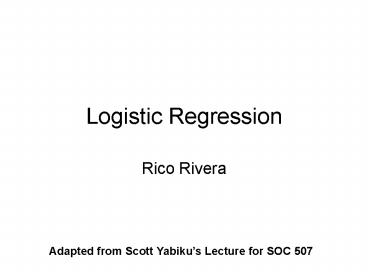Logistic Regression - PowerPoint PPT Presentation
1 / 30
Title:
Logistic Regression
Description:
The odds of an event occuring is the ratio of the probability of that event ... How can we compare the odds (?) of males versus females ... – PowerPoint PPT presentation
Number of Views:44
Avg rating:3.0/5.0
Title: Logistic Regression
1
Logistic Regression
- Rico Rivera
Adapted from Scott Yabikus Lecture for SOC 507
2
Overview
- Purpose of Logistic Regression
- Likelihood
- Probability of an event
- Odds of an event occurs vs not occuring
- Odds - Ratio
3
Why do you need Logistic Regression?
- Predict the likelihood of discrete outcomes
- Group membership
- Binary outcome (disease/no disease)
- Quite Flexible Statistical Assumptions
- No assumptions about the distributions of the
predictor variables. - Predictors do not have to be normally distributed
- Does not have to be linearly related.
- Does not have to have equal variance within each
group.
4
Likelihood of Dichotomous Outcomes
- Binary dependent variables (0, 1) have two
possible outcomes (e.g., success failure) - Success (y 1) failure (y 0).
- Goal is to estimate or predict the likelihood of
success or failure, conditional on a set of
independent variables.
5
Likelihood of Dichotomous Outcomes
- p
- Odds
- Odds Ratio
6
What is p?
- p probability (or proportion)
7
What is p?
- p probability (or proportion)
- The lower bound is 0, and the upper bound is 1.
- Probability of success Pr(y 1) p
- Probability of failure Pr(y 0) 1 p
8
What is the p of success or failure?
9
What is the p of success or failure?
10
What is the p of success or failure?
11
What is the p of success?
12
What is the p of success?
13
What are odds?
- Odds are related to probabilities
- The odds of an event occuring is the ratio of the
probability of that event occurring to the
probability of the event not occuring. - Odds of success p of success divided by p of
failure - omega (?) p/(1-p)
14
What are the odds of success?
- omega (?) p/(1-p)
- ? .75/ (1 - .75)
- ? .75/.25 3
15
What is an odds ratio?
- The odds ratio compares the odds of success for
one group to another group. - Theta (?) ?groupA pA/(1-pA)
- ?groupB pB/(1-pB)
16
How can we compare the odds (?) of males versus
females
17
How can we compare the odds (?) of males versus
females
18
How can we compare the odds (?) of males versus
females
19
How can we compare the odds (?) of males versus
females
20
How can we compare the odds (?) of males versus
females
- ?groupA pA/(1-pA)
- ?groupB pB/(1-pB)
21
How can we compare the odds (?) of males versus
females
- ?male .67/.33
- ?female .83/.17
22
How can we compare the odds (?) of males versus
females
- ?male .67/.33 2.03
- ?female .83/.17 4.88
- Theta (?) ?groupA / ?groupB
23
How can we compare the odds (?) of males versus
females
- Theta (?) ?groupA / ?groupB
- ?male / ?female 2.03 / 4.88
- ?male / ?female .4160
- The odds that males succeeds compared to females
are only .416 times that of females
24
How can we compare the odds (?) of males versus
females
- How about ? ?groupB / ?groupA
- ?female / ?male 4.88 / 2.03 2.404
- The odds that females succeeds compared to the
odds that males succeeds are 2.40 times that of
males (or, 2.40 times greater). - Or, you could say the odds for females are 218
greater. - Take the odds ratio and subtract 1.
25
What is so special about 1
- Take the odds ratio and subtract 1.
- Whats so special about 1? 1.00 is the null
effectwhen the odds ratio is 1.00, there is no
difference in the odds for one group relative to
the other. - So when we describe odds ratios, we often
describe them by how much they differ from 1.00
26
Why is it called Logistic regression?
- It uses the logit transformation.
- The logistics transformation can be interpreted
as the logarithm of the odds of success vs.
failure.
27
Lets go through an example
28
What are the odds of favoring gun permits? What
are the odds that a male respondent favors gun
permits? What is the odds ratio for a male
favoring gun permits compared to a female? What
is the log odds ratio for a male favoring gun
permits compared to a female?
29
Lets run it in SPSS
- 1st, I recommend that you recode any binary
variables into new variables with categories 0
and 1. - Transform gt Recode gt into a different variable
- Subsequently Analyze gt Regression gt Binary
Logistic
30
Example Output































